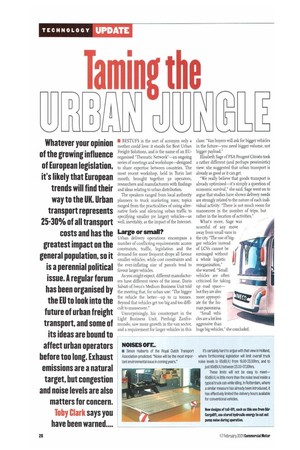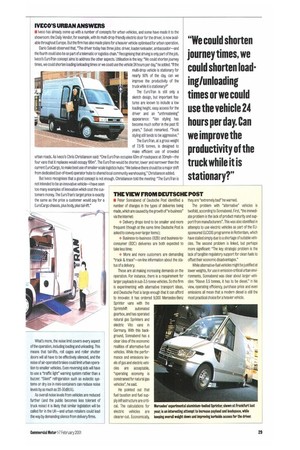Ta mg the
Page 130

Page 131

If you've noticed an error in this article please click here to report it so we can fix it.
•
Whatever your opinion of the growing influence of European legislation, it's likely that European trends will find their way to the UK. Urban transport represents 25-30% of all transport costs and has the greatest impact on the general population, so it is a perennial political issue. A regular forum has been organised by the EU to look into the future of urban freight transport, and some of its ideas are bound to affect urban operators before too long. Exhaust emissions are a natural target, but congestion and noise levels are also matters for concern. Toby Clark says you have been warned....
• BESTUFS is the sort of acronym only a mother could love; it stands for Best Urban Freight Solutions, and is the name of an EUorganised "Thematic Network"—an ongoing series of meetings and workshops—designed to share expertise between countries. The most recent workshop, held in Turin last month, brought together 30 operators, researchers and manufacturers with findings and ideas relating to urban distribution.
The speakers ranged from local authority planners to truck marketing men; topics ranged from the practicalities of using alternative fuels and silencing urban traffic to specifying smaller (or larger) vehicles—as well, inevitably, as the impact of the Internet.
Large or small?
Urban delivery operations encompass a number of conflicting requirements: access constraints, traffic, legislation and the demand for more frequent drops all favour smaller vehicles, while cost constraints and the ever-inflating size of parcels tend to favour larger vehicles.
As you might expect, different manufacturers have different views of the issue. Dario Salvafi of Iveco's Medium Business Unit told the meeting that, for urban use: "The bigger the vehicle the better—up to 12 tonnes. Beyond that vehicles get too big and too difficult to manoeuvre."
Unsurprisingly, his counterpart in the Light Business Unit, Pierluigi Zanframundo, saw more growth in the van sector, and a requirement for larger vehicles in this class: "Van buyers will ask for bigger vehicles in the future—you need bigger volume, not bigger payload."
Elisabeth Sage of P SA Peugeot Citroen took a rather different (and perhaps pessimistic) view: she suggested that urban transport is already as good as it can get.
"We really believe that goods transport is already optimised—it's simply a question of economic survival," she said. Sage went on to argue that studies have shown delivery needs are strongly related to the nature of each individual activity: "There is not much room for manoeuvre in the number of trips, but rather in the location of activities,"
What's more, Sage was scornful of any move away from small vans in the city. 'The use of bigger vehicles instead of LCVs cannot be envisaged without a whole logistic reorganisation," she warned. "Small vehicles are often criticised for taking up road space— but they are also more appropriate for the human panorama.
"Small vehicles are a lot less aggressive than huge big vehicles," she concluded.
THE VIEW FROM DEUTSCHE POST
III Peter Sonnabend of Deutsche Post identified a number of changes in the types of deliveries being made, which are caused by the growth of "e-business" via the Internet:
• Delivery drops tend to be smaller and more frequent (though at the same time Deutsche Post is asked to convey ever-larger items); • Business-to-business (B2B) and business-toconsumer (B2C) deliveries are both expected to take less time; • More and more customers are demanding "track & trace"—on-line information about the status of a delivery.
These are all making increasing demands on the operation. For instance, there is a requirement for larger payloads in sub-3.5-tonne vehicles. So the firm is experimenting with alternative transport ideas, and Deutsche Post is large enough that it can afford to innovate: it has ordered 9,000 Mercedes-Benz Sprinter vans with the Sprintshift automated gearbox, and has operated natural gas Sprinters and electric Vito vans in Germany. With this background, Sonnabend has a clear idea of the economic realities of alternative-fuel vehicles. While the performance and emissions levels of gas and electric vehicles are acceptable, "operating economy is constrained for natural gas vehicles", he said.
He pointed out that fuel taxation and fuel supply infrastructure are critical. The calculations for electric vehicles are clearer-cut. Economically, they are "extremely bad" he warned.
The problem with "alternative" vehicles is twofold, according to Sonnabend. First, "the immediate problem is the lack of product maturity and support from manufacturers". This was also identified in attempts to use electric vehicles as part of the FUsponsored ELCIDIS programme in Rotterdam, which have stalled simply due to a shortage of suitable vehicles. The second problem is linked, but perhaps more significant: "The key strategic problem is the lack of tangible regulatory support for clean fuels to offset their economic disadvantages."
While alternative-fuel vehicles might be justified at lower weights, for use in emission-critical urban environments, Sonnabend was clear about larger vehicles: "Above 3.5 tonnes, it has to be diesel." In his view, operating efficiency, purchase price and even emissions all mean that a modern diesel is still the most practical choice for a heavier vehicle.




































































































































































































